



what does polyacrylamide do
The Role of Polyacrylamide in Various Applications
Polyacrylamide is a versatile synthetic polymer that has found widespread use in various fields, including agriculture, water treatment, and biotechnology. Composed of acrylamide monomers, polyacrylamide can be produced in different forms, such as gel and powder, each suited for specific applications. Its unique properties, such as water retention, flocculation, and gel formation, make it invaluable across multiple industries. This article explores what polyacrylamide does and highlights its significance in real-world applications.
1. Water Treatment
One of the most prominent uses of polyacrylamide is in water treatment processes. Polyacrylamide acts as a coagulant and flocculant, helping to aggregate suspended particles, which facilitates their removal from water. In municipal water treatment facilities, polyacrylamide is added to clarify drinking water by promoting the sedimentation of pollutants. Similarly, it plays a crucial role in wastewater treatment by aiding in the removal of suspended solids. This application is particularly important in industrial processes where effluent must meet strict environmental regulations.
2. Soil Improvement in Agriculture
Polyacrylamide is also widely used in agriculture, particularly in soil management and water conservation. When applied to soil, polyacrylamide can improve its structure and increase its water retention capacity. This is especially beneficial in arid regions and for crops that require consistent moisture levels. By reducing soil erosion and enhancing water absorption, polyacrylamide helps to improve agricultural productivity. It acts as a soil conditioner, making it ideal for various farming practices, including rain-fed and irrigated agriculture.
what does polyacrylamide do

In the oil industry, polyacrylamide is used in enhanced oil recovery (EOR) techniques. During the extraction of crude oil, much of the oil can remain trapped in the reservoirs. Polyacrylamide is injected into oil wells to increase the viscosity of water used in the recovery process, allowing for more efficient displacement of oil. This method not only boosts the amount of recoverable oil but also reduces the environmental impact of oil extraction by minimizing the need for additional drilling.
4. Biotechnology and Medicine
The biotechnology field has also embraced polyacrylamide, particularly in gel electrophoresis. Polyacrylamide gels are ideal for separating DNA, RNA, and proteins based on size and charge during laboratory procedures. This application is fundamental in genetic research, protein analysis, and various diagnostics. Furthermore, polyacrylamide is being explored for drug delivery systems and tissue engineering due to its biocompatibility and ability to form hydrogels.
5. Cosmetic and Personal Care Products
In the cosmetic industry, polyacrylamide is used as a thickening agent, emulsifier, and film-forming agent in lotions, creams, and other personal care products. Its ability to enhance the texture and performance of beauty products makes it a popular choice among formulators. However, its use has raised discussions regarding safety, leading to ongoing research and regulation to ensure consumer health.
Conclusion
Polyacrylamide is an essential polymer that fulfills diverse roles across various industries. Its capabilities in water treatment, agriculture, oil recovery, biotechnology, and cosmetics underscore its versatility and importance. While its benefits are significant, it is also crucial to continue research into its safety and environmental impact to ensure sustainable use. As industries evolve and face new challenges, polyacrylamide is likely to adapt and continue to play a crucial role in various technological advancements for years to come.
-
Why Sodium Persulfate Is Everywhere NowNewsJul.07,2025
-
Why Polyacrylamide Is in High DemandNewsJul.07,2025
-
Understanding Paint Chemicals and Their ApplicationsNewsJul.07,2025
-
Smart Use Of Mining ChemicalsNewsJul.07,2025
-
Practical Uses of Potassium MonopersulfateNewsJul.07,2025
-
Agrochemicals In Real FarmingNewsJul.07,2025
-
Sodium Chlorite Hot UsesNewsJul.01,2025










